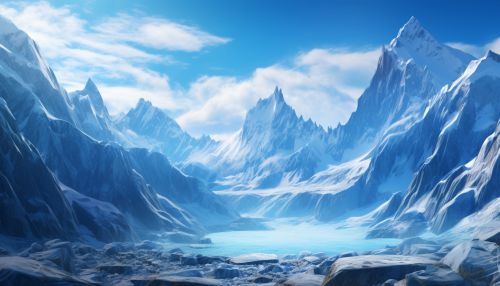Glacier
Introduction
A Glacier is a large, persistent body of dense ice that is constantly moving under its own weight. It forms where the accumulation of snow exceeds its ablation (melting and sublimation) over many years, often centuries. Glaciers slowly deform and flow due to stresses induced by their weight, creating crevasses, seracs, and other distinguishing features. They also abrade rock and debris from their substrate to create landforms such as cirques and moraines.


Formation and Characteristics
Glaciers form on land, often elevated, and are distinct from the much thinner sea ice and lake ice that form on the surface of bodies of water. They originate from the accumulation of snow. This snow turns to firn, which eventually turns into ice. A glacier requires a certain amount of snowfall each year to form and continue to exist. This is known as the glacier's mass balance.
Glaciers are categorized by their morphology, thermal characteristics, and behavior. Cirque glaciers form in bowl-shaped depressions, or cirques, while valley glaciers are long, often ribbon-like glaciers that flow down valleys. Ice caps cover peaks and plateaus, while ice sheets cover larger areas and are not confined by the landscape.
Movement and Dynamics
Glaciers move, or 'flow', due to a combination of surface slope, gravity and pressure. In temperate glaciers, the ice is near its melting point, allowing it to deform and flow more easily. The speed of glacier movement is largely determined by four factors: the gradient of the slope, the thickness of the ice, the temperature, and the amount of water at the glacier bed.
The movement of a glacier is a key factor in its ability to erode its underlying substrate. As a glacier moves, it carries with it rock and debris, which can be deposited as the glacier recedes. These deposits, known as till, can create a variety of landforms, including moraines, drumlins, and eskers.
Impact on the Environment and Ecosystems
Glaciers have a major impact on the environment and ecosystems. They are a significant store of freshwater and can be important as water sources for human use, such as irrigation, drinking water, and hydroelectric power. Glaciers also influence sea level changes, with their melt contributing to sea level rise.
Glaciers can also create and modify habitats for various organisms. In high mountain ecosystems, for example, glaciers often provide a source of cold water in otherwise dry landscapes. This can support unique communities of plants and animals, especially invertebrates.
Human Interaction and Study
Human interaction with glaciers has primarily been in the context of navigation and resources. However, in recent years, the focus has shifted towards the study and understanding of glaciers due to their sensitive response to climate change. Glaciology, the study of glaciers, has become a major focus of research in the fields of geology, physical geography, and climate science.
Glaciers are also a popular tourist attraction in some parts of the world, with their grandeur and beauty attracting millions of visitors each year. This has led to the development of various forms of glacier tourism, including hiking, climbing, and ice caving.
